The innovations of the pioneering Disney Music Group composer/conductor, who would have been 105 this Friday May 11th, still influence every groove, disc and download.
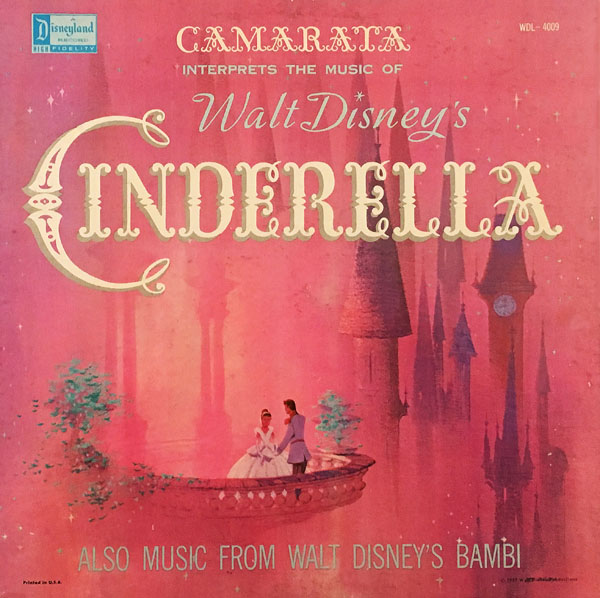
CAMARATA Interprets the Music of Walt Disney’s
CINDERELLA and BAMBI
Camarata Chorus and Orchestra
Disneyland Records WDL-4009 (12” 33 1/3 RPM / Mono)
Released in January, 1957. Executive Producer; Jimmy Johnson. Producer/Arranger/Conductor: Camarata. Recorded at American Legion Hall #43, Los Angeles. Running Time: 35 minutes.
Cinderella Songs: “Bibbidi-Bobbidi-Boo,” “Oh Sing Sweet Nightingale,” “Cinderella” by Mack David, Al Hoffman and Jerry Livingston.
Cinderella Instrumentals: “So This is Love,” “The Work Song,” “A Dream is a Wish Your Heart Makes,” by Mack David, Al Hoffman and Jerry Livingston.
Bambi Songs: “Little April Shower,” “Love is a Song,” “Let’s Sing a Gay Little Spring Song.” “I Bring You a Song” by Larry Morey, Frank Churchill.
Bambi Instrumental: “Bambi Overture” by Frank Churchill.

Despite his nickname, Salvador “Tutti” Camarata was not one to toot his own horn. He preferred to let his work in compositions, arrangements and conducting speak for itself—and it did, for the biggest film, radio, recording and TV stars of the twentieth century, like Ella Fitzgerald, Frank Sinatra, Bing Crosby, Billie Holiday, Jackie Gleason, Louis Armstrong, Mary Martin and Bob Hope.
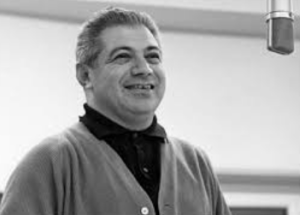 When he began his career as A & R (artists and repertoire) Director at Disneyland and Buena Vista Records, that fledgling division was in its infancy. In bringing in a versatile talent like Camarata, they were getting many musical directors in one. Because of his varied background in classical, jazz, popular and show music, he could create a rock and roll record as easily as conduct a Beethoven concerto.
When he began his career as A & R (artists and repertoire) Director at Disneyland and Buena Vista Records, that fledgling division was in its infancy. In bringing in a versatile talent like Camarata, they were getting many musical directors in one. Because of his varied background in classical, jazz, popular and show music, he could create a rock and roll record as easily as conduct a Beethoven concerto.
With the Sherman Brothers, he created the “Annette Sound,” a specific type of vocal doubling that involved equalization on the second voice. It was Camarata who created the much-imitated tempo change dance song in the big band era that generated a parade of hits for Bob Eberle and Helen O’Connell with Jimmy Dorsey’s band.
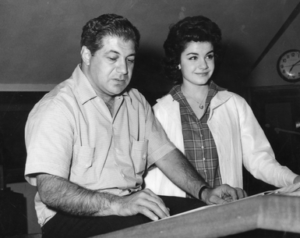 When Disney Legend Jimmy Johnson began Disneyland Records, one of his first projects was to produce long-playing soundtrack albums of the classic Disney animated films, which had never been done before. Camarata stunned the Disney staffers by closing his eyes during the screening of the films in order to experience the scores as pure music. When he selected and edited each album, the music and songs were arranged as for the home listener rather than the moviegoer. Vocals and instrumentals might be moved out of sequence a bit if it served the overall playback. The presentational format of overture, performance and finale were used. In effect, Camarata established a soundtrack album format in the late 1950s unlike the more prevalent system of three-minute segments based on the playing length of 78 and 45 RPM records.
When Disney Legend Jimmy Johnson began Disneyland Records, one of his first projects was to produce long-playing soundtrack albums of the classic Disney animated films, which had never been done before. Camarata stunned the Disney staffers by closing his eyes during the screening of the films in order to experience the scores as pure music. When he selected and edited each album, the music and songs were arranged as for the home listener rather than the moviegoer. Vocals and instrumentals might be moved out of sequence a bit if it served the overall playback. The presentational format of overture, performance and finale were used. In effect, Camarata established a soundtrack album format in the late 1950s unlike the more prevalent system of three-minute segments based on the playing length of 78 and 45 RPM records.
Camarata also had a remarkable ear for acoustics, and like other conductors who would rather record in cathedrals and music halls than studios, he chose recording locations based on sound quality. He discovered a sonic treasure in an unlikely location, which still stands in the same location where The Music of Cinderella and Bambi was recorded.
Johnson recalls the experience in his autobiography, Inside the Whimsy Works: MY Thirty-Seven Years with Walt Disney Productions:
“One day we were riding down Highland Avenue in Hollywood and passed the impressive concrete mass of the American Legion Hall. Tutti suggested we check the building out and so we did. He went into a handclapping act to check the acoustics and found that they were fabulous.
‘We’ve got to try this place,’ he said. ‘I wonder how we go about it?’
“I suggested we start by contacting the Board of the Legion Post. They were astounded that anyone should want to record in their hall but were agreeable to let Disney use it. They advised that they were a nonprofit corporation and therefore couldn’t charge any rent but said we could make a contribution to their post fund.”
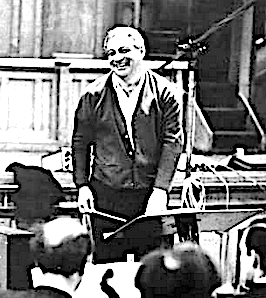 The first Disneyland album recorded there was called Folk Songs from the Far Corners featuring Frances Archer and Beverly Gile. Coincidentally, this folk duo—who had been personally signed by Walt Disney and showcased on the Mickey Mouse Club TV show—also headlined the first record with the Disneyland Records imprint, A Child’s Garden of Verses (available to this day on iTunes). Folk Songs from the Far Corners was unique because Camarata once again innovated by setting folk tunes to full orchestrations. Johnson continues:
The first Disneyland album recorded there was called Folk Songs from the Far Corners featuring Frances Archer and Beverly Gile. Coincidentally, this folk duo—who had been personally signed by Walt Disney and showcased on the Mickey Mouse Club TV show—also headlined the first record with the Disneyland Records imprint, A Child’s Garden of Verses (available to this day on iTunes). Folk Songs from the Far Corners was unique because Camarata once again innovated by setting folk tunes to full orchestrations. Johnson continues:
“We set a date, moved a ton of not-so-portable recording equipment into the second-floor offices, sent miles of cables snaking through the building and went to work. The results were sensational, the sound being absolutely fantastic, and Archer and Gile plus orchestral backing were something else again.
“One of the reasons Hollywood is the recording capital of the world is the large pool of experienced recording musicians. Even so, the same faces show up on record dates for many different companies. The musicians on the Archer and Gile dates went out of their minds. The word spread like wildfire that there was a fabulous new (old) place to record in town.
“Suddenly the American Legion was besieged by requests to record in their hall and they finally had to say no to everyone. We were permitted to do one more album there, Camarata’s version of the Cinderella and Bambi scores, before they closed the door to recording.
“However, a few years later Columbia was looking for a studio to record all of Beethoven’s symphonies with Bruno Walter. They knew about the American Legion hall and approached the Post with an offer of many thousands of dollars. Money talked and the offer was accepted. Needless to say the sound was magnificent.”
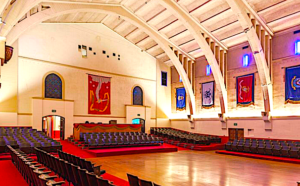 The arrangements for Cinderella and Bambi are, as one would expect from Camarata, expressive and varied in tone. One moment the mood is playful and goofy, as in the spoken moments of “Bibbidi-Bobbidi-Boo,” another it’s sophisticated and alluring, as in the rarely-covered “O Sing Sweet Nightingale.” Camarata’s take on the Oscar-nominated “Love is a Song” is a soaring, spectacular orchestral and choral work of such emotive power, it is easily one of the all-time greatest renditions of a Disney tune.
The arrangements for Cinderella and Bambi are, as one would expect from Camarata, expressive and varied in tone. One moment the mood is playful and goofy, as in the spoken moments of “Bibbidi-Bobbidi-Boo,” another it’s sophisticated and alluring, as in the rarely-covered “O Sing Sweet Nightingale.” Camarata’s take on the Oscar-nominated “Love is a Song” is a soaring, spectacular orchestral and choral work of such emotive power, it is easily one of the all-time greatest renditions of a Disney tune.
The full-sized album art on each side of the cover, presumably done by Disney artist Dick Kelsey, is nothing less than stunning. Each monochromatic masterpiece is further proof that there should be a gallery showing of this material.
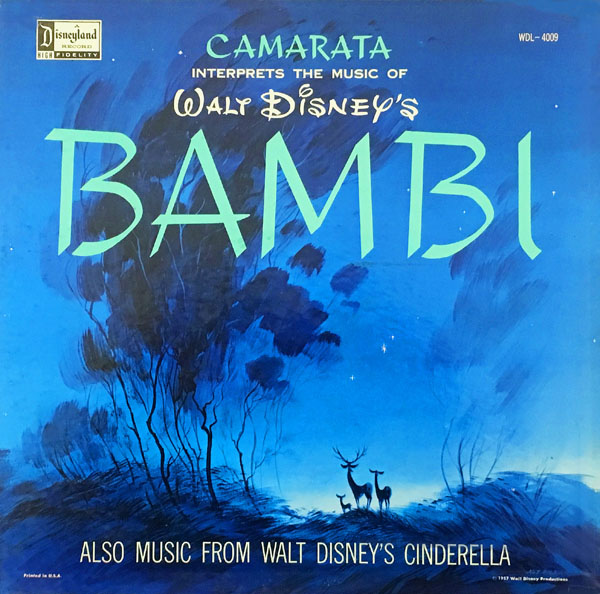
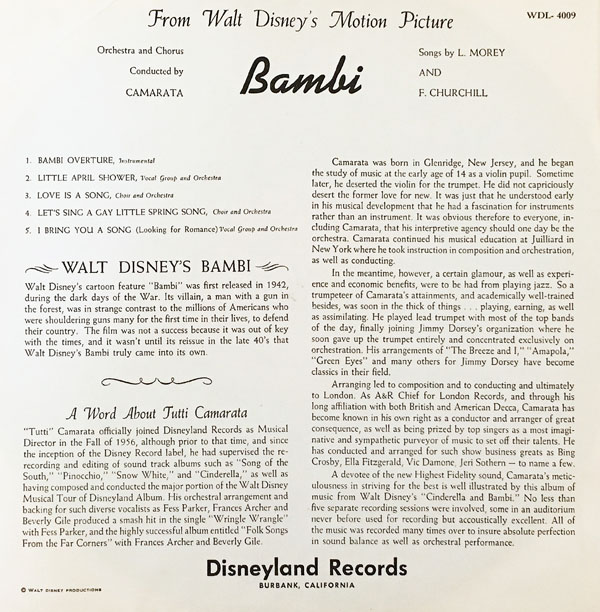
“Bambi Overture”
Camarata was a master of overtures and medleys. Of special note are the intricate trumpets in the “Little April Shower” section of this Bambi overture. This is one of the trademark arrangement flourishes of “Tutti’s Trumpets,” a group of top-flight Hollywood studio musicians who regularly recorded with Camarata. You’ll also hear this effect on the Hi-Ho album that Mary Martin recorded for Disney. Another Camarata touch is the eight-note countermelody added into the first two lines of “Love is a Song” in the overture and the full-length song elsewhere on the LP. It’s one of those little touches that feels natural enough to have originated within the song, yet it was created for this record. By the way, this overture and other portions of the album are heard every day in Fantasyland attraction areas at Disneyland in California.
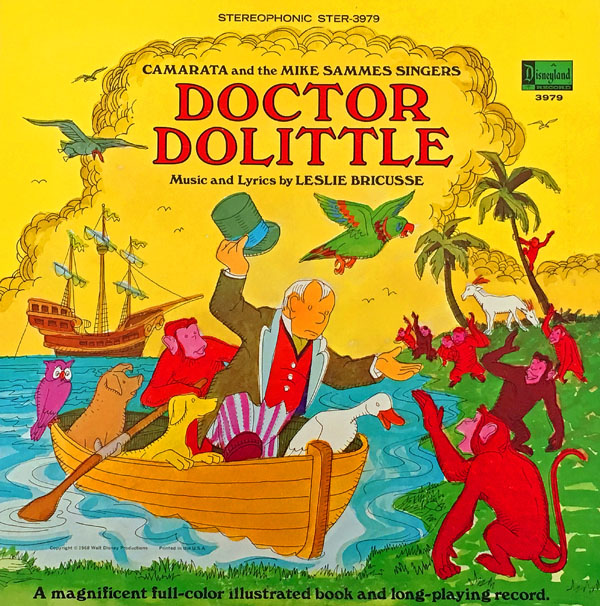
DOCTOR DOLITTLE
Camarata and The Mike Sammes Singers
Disneyland Records STER-1325 (No Book) (Stereo) DQ-1325 (Mono) December 1967
Disneyland Records Storyteller (With Book) STER-3979 (Stereo) ST-3979 (Mono) September 1968
Executive Producer: Jimmy Johnson. Producer/Conductor: Camarata. Orchestrations: Brian Fahey. Recorded at Abbey Road Studios, London. Running Time (1325): 17 minutes. Running Time (3979): 36 minutes.
Songs: “Doctor Dolittle,” “Talk to the Animals,” “Beautiful Things,” “My Friend, The Doctor,” “At the Crossroads,” “I’ve Never Seen Anything Like It” by Leslie Bricusse.
Additional Songs (3929 only): “Where Are the Words?” “After Today,” “Fabulous Places,” “Something in Your Smile,” “When I Look in Your Eyes” by Leslie Bricusse.
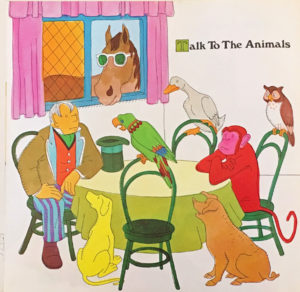 The Storyteller book-and-record version of this album of songs (from the 1967 musical film starring Rex Harrison) is included here for several reasons. It is notable as one of several outstanding albums Camarata conducted at Abbey Road Studios in the late ‘60s at the same time such artists as The Beatles were also recording there (The Mike Sammes Singers were the backup for The Beatles in “Good Night,” “I Am the Walrus” and “The Long and Winding Road”). Camarata and The Mike Sammes Singers worked on many other superb albums together for Disney scores like The Aristocats and Bedknobs and Broomsticks as well as non-Disney works (for Disney labels) like Man of LaMancha and Fiddler on the Roof.
The Storyteller book-and-record version of this album of songs (from the 1967 musical film starring Rex Harrison) is included here for several reasons. It is notable as one of several outstanding albums Camarata conducted at Abbey Road Studios in the late ‘60s at the same time such artists as The Beatles were also recording there (The Mike Sammes Singers were the backup for The Beatles in “Good Night,” “I Am the Walrus” and “The Long and Winding Road”). Camarata and The Mike Sammes Singers worked on many other superb albums together for Disney scores like The Aristocats and Bedknobs and Broomsticks as well as non-Disney works (for Disney labels) like Man of LaMancha and Fiddler on the Roof.
These show score albums were designed for easy listening for adults of the ‘60s, the kind of thing that Darrin and Samantha Stephens might play when Larry Tate brought clients over for cocktails in their home on Morning Glory Circle. There are light bossa novas, exciting bongo-driven beats, mellow ballads and peppy fox trots.
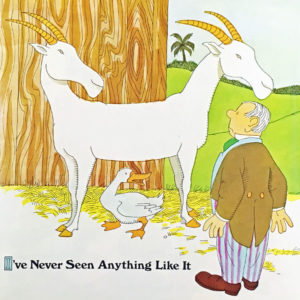 A family-friendly score like Doctor Dolittle’s could be marketed to kids as well as adults, so in this case, it was sold on the Disneyland label instead of the more grownup Buena Vista brand. The lower-priced six-song Disneyland version of this album—with the red cover and the hat—was one of many record albums mounted on the office wall of Arthur P. Jacobs, producer of 1967’s Doctor Dolittle for 20th Century Fox, among the myriad of LP’s interpreting the Bricusse songs, including Bobby Darin and Sammy Davis, Jr.
A family-friendly score like Doctor Dolittle’s could be marketed to kids as well as adults, so in this case, it was sold on the Disneyland label instead of the more grownup Buena Vista brand. The lower-priced six-song Disneyland version of this album—with the red cover and the hat—was one of many record albums mounted on the office wall of Arthur P. Jacobs, producer of 1967’s Doctor Dolittle for 20th Century Fox, among the myriad of LP’s interpreting the Bricusse songs, including Bobby Darin and Sammy Davis, Jr.
Another reason for exploring this album is that Walt Disney once desired to produce Doctor Dolittle as a feature film. (While that never happened during his lifetime, his company is purchasing the company that produced the 1967 film, 20th Century Fox.) Johnson, who was in charge of the studio tour for Dolittle author/illustrator Hugh Lofting, wrote:
“One of my duties in Publicity was to conduct tours for these V.I.P.s and then wind up in Walt’s office for the payoff. My chronicle for December 14, l938 contains the following entry:
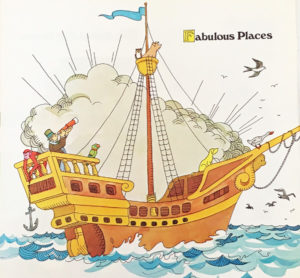
‘On Monday I took Mr. Sulzberger and his wife (he’s publisher of The New York Times) on a tour of the studio. In this project, I was aided and abetted by Walt Disney himself, who was running around like a traffic boy [the studio name for an entry-level delivery clerk], so big were the shots. Mr. Sulzberger was interesting and interested.
‘But it was Walt who impressed me. I was with him for probably an hour and a half and he was doing one of the things I am sure he likes to do best: show off the work his studio is doing. His rapid speeches on a sequence from Pinocchio came tumbling one after another. These were punctuated by quick quizzical ‘You know what I mean’s. Not waiting for an answer he would “pour on,” tremendously enthused about it all, acting it all out as he went.’
“I toured many other V.I.P.’s, including social queen Elsa Maxwell, Hollywood Citizen News columnist Mort Thompson, actor/writer Noel Coward, movie star Roland Young – and Paul Hindemith, a modern composer who was shocked at what the Disney studio was doing to Bach’s Toccata and Fugue for Fantasia.
“Then there were Hugh Lofting and his wife. Walt was very interested in his Doctor Dolittle books and Lofting was interested in the Disney studio. However, the author’s idea of what Doctor Dolittle was worth as a motion picture property and what Walt could afford to pay for a story in those days were far apart. No deal ever came about.”
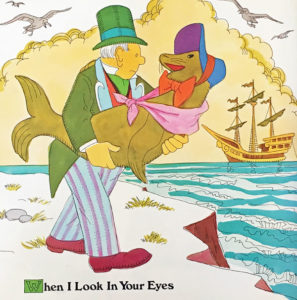 Johnson knew this first hand when he oversaw the Storyteller version of Doctor Dolittle, which was released in 1968, a year after the film’s debut. The uncredited artist of the book was instructed to illustrate the pictures in Lofting’s style. While LP itself did not tell a story and only songs from the film, the book did follow the very basic movie plot and the Lofing-style pictures were followed it in a specific order.
Johnson knew this first hand when he oversaw the Storyteller version of Doctor Dolittle, which was released in 1968, a year after the film’s debut. The uncredited artist of the book was instructed to illustrate the pictures in Lofting’s style. While LP itself did not tell a story and only songs from the film, the book did follow the very basic movie plot and the Lofing-style pictures were followed it in a specific order.
What is interesting is that each picture has a song assigned to it that usually matches its place in the film, but a few do not. Some songs are put in different scenes to fit where their order on the record, yet when the listener follows the songs on the record with the pages, it works as a cohesive whole. Based on the fact that Jimmy Johnson, who spent his career on Roy Disney’s business side of the company but longed to be a story artist on Walt’s creative side (and had applied with story ideas of his own), one could speculate that this Doctor Dolittle album was his way of “storyboarding” the Fox musical as if it were a Disney animated feature!
“At the Crossroads”
This version of the plaintive song that Emma Fairfax sings about her future becomes sheer “show biz glitz” on this LP—it’s the Technicolor ‘60s at the height of musical variety. Imagine a ride on the world’s fastest sports cars in Monte Carlo! Or the opening montage of a big, splashy TV special in which Ann-Margret, Gene Kelly and Petula Clark have just arrived in Europe for a fast-paced sightseeing tour. Hey, how did they happen get on the stage of the London Palladium? “Look at the crowds!” “We love you too, everyone!” (Cue the applause!) “Ladies and gentlemen, The Mike Sammes Singers!”


 GREG EHRBAR is a freelance writer/producer for television, advertising, books, theme parks and stage. Greg has worked on content for such studios as Disney, Warner and Universal, with some of Hollywood’s biggest stars. His numerous books include Mouse Tracks: The Story of Walt Disney Records (with Tim Hollis). Visit
GREG EHRBAR is a freelance writer/producer for television, advertising, books, theme parks and stage. Greg has worked on content for such studios as Disney, Warner and Universal, with some of Hollywood’s biggest stars. His numerous books include Mouse Tracks: The Story of Walt Disney Records (with Tim Hollis). Visit 






















































Fellow Disney legend Gloria Wood worked with fellow singer Harry Babbitt in Kay Kysers On a Slow Boat to China which utilized the Camarata/O’Connell/Dorsey/Eberle format. Note even if Miss Wood wasn’t a Legend she dud do Disney records I believe Gloria is a legend interesting classic rock band Styx utilized the same format in their first hit Lady and for Come Sail Away for the slow then fast tempo. Despite his mentioned variety of style with Styx no Camarata involvement of course. Another article well done and I’ll have it with some sauce!
Gloria Wood with Harry Babbitt and Kay Kyser’s band recorded “Woody Woodpecker” in 1948, another cartoon connection for Gloria.
Camarata was one of those “right place at the right time” people who worked for Disney and wielded a special brand of magic as a sub-set to the overall Disney magic. His Cinderella and Bambi recordings offer delightful and highly listenable re-interpretations of these classic scores. The songs from Bambi don’t generally get much play in Disney retrospectives.
One can only imagine what a Disney-produced animated “Doctor Dolittle” would have been like, but I like to think it would have had a stellar performance at the box office–especially if it had been made under the guidance of Uncle Walt.
Where can I download the Cinderella album by Camarata? I’ve been looking for it for so much time.
Unfortunately the Cinderella/Bambi it has not yet been made available, but it might be someday.
I bought both, the ”Camarata Cinderella/Bambi album, as well as the ”Cinderella” 1956 soundtrack, (both from the rare ”Disney ”WDL 4000 series). They weren’t cheap, and they’re not spotless, but I consider myself lucky to have them. Because they were originally made for adult audiences way back when, the pressings and sound quality are superior to any versions that followed. The sophisticated cover art is sublime as well. I have ”Snow White” from the same series, and it is likewise great. As has been pointed out, ”Snow-White’s” subsequent pressings omitted some of the score on this edition-ultimately restored on the 1987 ”50th Anniversary version. Not so for the 1987 reissue of the ”Cinderella” soundtrack. I can’t help wondering why.